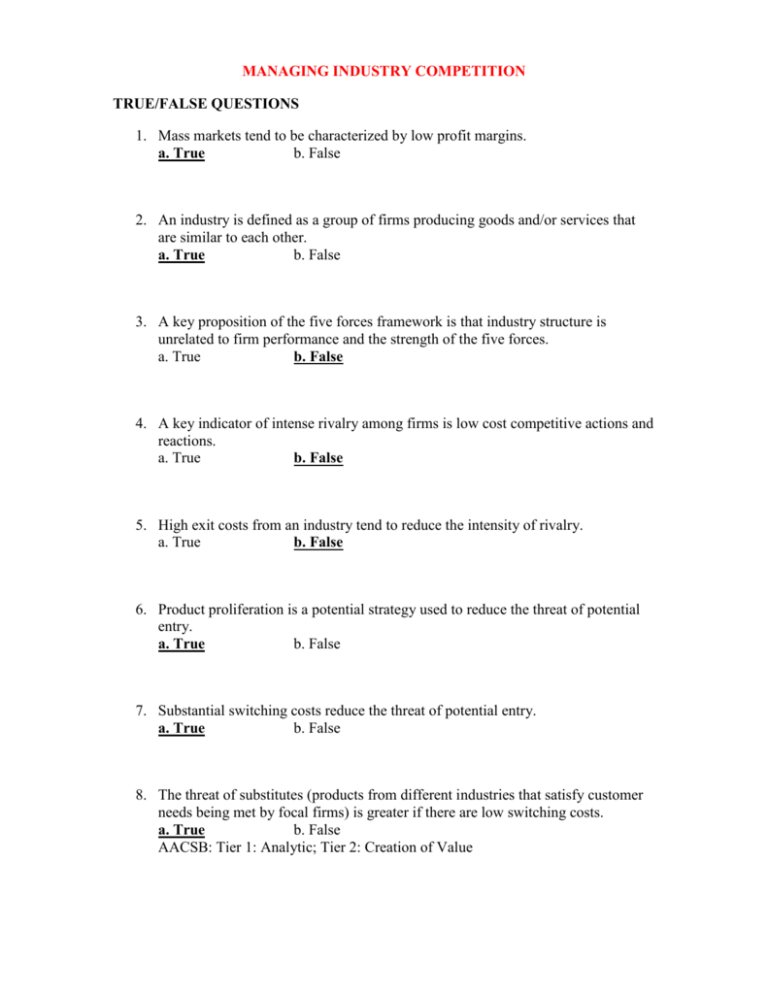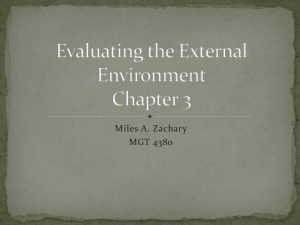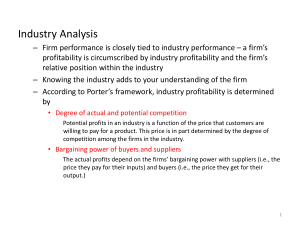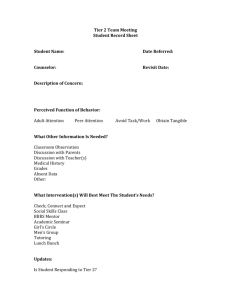MANAGING INDUSTRY COMPETITION TRUE/FALSE QUESTIONS
advertisement

MANAGING INDUSTRY COMPETITION TRUE/FALSE QUESTIONS 1. Mass markets tend to be characterized by low profit margins. a. True b. False 2. An industry is defined as a group of firms producing goods and/or services that are similar to each other. a. True b. False 3. A key proposition of the five forces framework is that industry structure is unrelated to firm performance and the strength of the five forces. a. True b. False 4. A key indicator of intense rivalry among firms is low cost competitive actions and reactions. a. True b. False 5. High exit costs from an industry tend to reduce the intensity of rivalry. a. True b. False 6. Product proliferation is a potential strategy used to reduce the threat of potential entry. a. True b. False 7. Substantial switching costs reduce the threat of potential entry. a. True b. False 8. The threat of substitutes (products from different industries that satisfy customer needs being met by focal firms) is greater if there are low switching costs. a. True b. False AACSB: Tier 1: Analytic; Tier 2: Creation of Value 9. Core features of the five forces model remain remarkably insightful when analyzing old industries but not new phenomena, such as e-commerce. a. True b. False 10. Japanese firms do not tend to maintain close relationships with their suppliers. a. True b. False AACSB: Tier 1: Analytic; Tier 2: Group Dynamics 11. One of the benefits of having a cost advantage is that it serves as barrier to entry. a. True b. False 12. If there are many buyers but only a few sellers, the buyers tend to have the most bargaining power. a. True b. False 13. If there are many sellers but only a few buyers, the sellers tend to have the most bargaining power. a. True b. False 14. The three generic strategies can strengthen a local firm’s position relative to the five forces. a. True b. False 15. A focused firm avoids being either a specialized differentiator or a specialized cost leader. a. True b. False 16. Choosing whether to perform activities differently than rivals or to perform different activities than competitors is the essence of the Three Generic Strategies. a. True b. False 17. Telecommunications is an example of one industry in which one can determine exact boundaries. a. True b. False 18. Strategic alliances are on the decline. a. True b. False AACSB: Tier 1: Analytic; Tier 2: Group Dynamics 19. The five forces model over-emphasizes threats and downplays opportunities. a. True b. False AACSB: Tier 1: Reflective Thinking; Tier 2: Motivation Concepts 20. If a low-cost firm has already achieved the maximum efficient scale, it must turn to differentiation to distinguish itself from competitors. a. True b. False 21. Strategies of firms within a strategic group tend to be different, so does their performance. a. True b. False 22. Recent success of firms in unattractive industries suggests that firm-specific resources and capabilities are not needed to determine firm performance. a. True b. False 23. The industry-based view ignores the impact of industry history and institutions on firm performance. a. True b. False 24. The traditional view recommends avoidance of integration. a. True b. False 25. Recent work favors outsourcing and willingness to collaborate with suppliers/buyers, as well as competitors. a. True b. False MULTIPLE CHOICE QUESTIONS 1. The luxury market is characterized by: a. Fewer competitors than in a mass market. b. Less use of incentives and price cuts to induce purchases. c. Healthier profit margins than in a mass-market segment. d. All of the above. e. None of the above. AACSB: Tier 1: Analytic; Tier 2: Motivation Concepts 2. The ultra luxury automobile market is characterized by: a. Little competition in the past – but that is changing. b. A small number of cars produced each year – but they are very expensive. c. Being the same as the luxury market. d. A and B above. e. None of the above. AACSB: Tier 1: Analytic; Tier 2: Creation of Value 3. Which of the following is NOT true of the industrial organization (IO) economics model? a. Industry structure determines firm conduct (strategy), which determines firm performance. b. Original goal – help regulators set policy to minimize the ability of firms to earn excess profits. c. Strategists use the IO model to try to earn above-average returns (excess profits). d. All of the above are NOT true. e. All of the above ARE true. 4. Which of the following tends to reduce the intensity of rivalry? a. Similarity of firms in terms of size, market influence and product offerings. b. Products are big-ticket items and purchased infrequently. c. New capacity must be added in large increments. d. Slow industry growth or decline in demand. e. None of the above. 5. Which of the following are scale-based low cost advantages? a. Experience curves. b. Proprietary technology. c. Favorable access to raw materials and distribution channels. d. Favorable locations. e. None of the above. 6. Which of the following would tend to reduce the bargaining power of suppliers? a. b. c. d. e. Dominance of the supplier industry by a few firms. Suppliers provide unique, differentiated products with few or no substitutes. Focal firm is not an important customer. Unwillingness and inability of suppliers to integrate forward. None of the above. AACSB: Tier 1: Analytic; Tier 2: Group Dynamics 7. Which of the follow would tend to reduce the bargaining power of buyers? a. Large number of buyers. b. Products of the industry do not produce clear cost advantages or enhance the quality of life for buyers. c. Purchase standard, undifferentiated commodity products from suppliers. d. Willingness and ability of buyers to integrate backward. e. All of the above. AACSB: Tier 1: Analytic; Tier 2: Group Dynamics 8. Which of the following are true concerning cost leadership? a. Targets average customers for mass market – little differentiation. b. Key functional areas are manufacturing and materials management. c. Relentless drive to cut costs might compromise value that customers desire. d. All of the above. e. None of the above. 9. Which is generally NOT true of differentiation? a. Difficult to sustain basis of differentiation in the long run. b. Relentless efforts of competitors to duplicate differentiation. c. Key areas of application include research and development, marketing/sales and after-sale services. d. It is a challenge to identify attributes that are valued by customers in each market segment. e. Inability to pass on suppliers’ price increases to buyers. 10. Related and supporting industries are called _________ and they are an additional force that can impact the competitiveness of an industry. a. Complementors b. All-rounders c. Customizers d. Flexible manufacturing e. Supporters 11. One noncontroversial issue with strategic groups is: a. b. c. d. e. Stability of strategic groups. Mobility barriers between strategic groups. The requirement for large quantities of objective data. All of the above are controversial issues. None of the above is controversial. 12. The industry-based view recommends: a. Backward integration as a way to defend against the power of suppliers. b. Backward integration as a way to defend against the power of buyers. c. Forward integration as a way to defend against the power of suppliers. d. Forward integration as a way to defend against the power of buyers. e. Backward or forward integration as a way to defend against the power of suppliers and buyers. 13. Which is a reason for integration as opposed to outsourcing? a. Greater expense. b. Strategic flexibility is enhanced. c. Those within the firm are often more competitive. d. The activity is crucial to the core business. e. All of the above. AACSB: Tier 1: Analytic; Tier 2: Motivation Concepts 14. Which is a reason for outsourcing as opposed to integration? a. Less expense. b. Strategic flexibility is enhanced. c. Those outside the firm are often more competitive. d. The activity is not crucial to the core business. e. All of the above. AACSB: Tier 1: Analytic; Tier 2: Motivation Concepts 15. Which of the following is NOT true regarding supplier relationships? a. Supplier relationships that are too close may introduce rigidities, including loss of flexibility. b. In Japan suppliers may become trusted members of the keiretsu. c. In Japan, instead of treating suppliers as adversaries, they are treated as collaboration partners. d. In view of A through C above, supplier relationships in Japan tend to be ineffective. e. In view of A through C above, close supplier relationships are not necessarily good or bad. AACSB: Tier 1: Reflective Thinking; Tier 2: Group Dynamics 16. Porter’s five forces framework: a. Identifies relevant variables but fails to ask the needed questions. b. Identifies only questions to ask. c. Identifies both relevant variables and questions to ask. d. Eliminates the need for other frameworks to add insight about firm performance. e. None of the above. 17. A systematic foundation for industry and competitor analysis is best provided by: a. The industry-based view. b. Resource-based view. c. Historical view. d. Macro analysis. e. None of the above. 18. An industry-based view provides some answers to which of the following questions? a. Why do firms differ? b. How do firms behave? c. What determines the scope of the firm? d. What determines the international success and failure of firms? e. All of the above. 19. Maximizing opportunities and minimizing threats presented by the five forces provides some answers to which of the following questions? a. Why do firms differ? b. How do firms behave? c. What determines the scope of the firm? d. What determines the international success and failure of firms? e. All of the above. 20. The relative bargaining power of the focal firm and (according to the traditional view) the degree of integration helps answer which of the following questions? a. Why do firms differ? b. How do firms behave? c. What determines the scope of the firm? d. What determines the international success and failure of firms? e. All of the above. SHORT ANSWER ESSAY QUESTIONS 1. An intense focus on above-average firm performance is shared by IO economists and those involved in the strategy of firms and yet their perspective is opposite of each other. Explain. IO economists and policymakers are concerned with the minimization rather than the maximization of above-average profits. The name of the game, from the perspective of strategists in charge of the profit-maximizing firm, is exactly the opposite—to try to earn above-average returns (of course, within legal and ethical boundaries). 2. How can high exit costs increase the chance that firms may continue to operate for at least a while when operating at a loss? Explain by giving examples. Specialized equipment and facilities that are of little or no alternative use, or that cannot be sold off, pose as exit barriers. In addition, emotional, personal, and career costs, especially on the part of executives admitting failure, may be high. In Japan and Germany, managers may be legally prosecuted if their firms file for bankruptcy. Thus, it is not surprising that these executives will try everything before admitting failure and taking their firms to exit the industry. 3. Many high-technology industries are characterized by network externalities. What are those externalities and how can they pay off? Network externalities pertain to the value a user derives from a product that increases with the number (or the network) of other users of the same product. These industries have a “winner take all” property, whereby winners (incumbents) whose technology standard is embraced by the market (such as Microsoft Word, Excel, and PowerPoint) are essentially locking out potential entrants. In other words, these industries have an interesting ““increasing returns” characteristic, as opposed to “diminishing returns” taught in basic economics. 4. How can backward integration be used by buyers and what are some examples? Backward integration involves obtaining control of a firm’s inputs instead of depending on other firms for those resources thus providing an internal alternative to outsiders. Buyers may thus enhance their bargaining power by entering the focal industry through backward integration. Buyers such as COSTCO, Tesco, and Marks & Spencer now directly compete with their own suppliers such as Procter & Gamble (P&G) and Johnson & Johnson by procuring store-brand products. Store brands (also known as private labels), such as Kirkland (for COSTCO), Kenmore (for Sears), Kroger, and Safeway brands, compete side-by-side with national brands on the shelf space. 5. What are the “Three Generic Strategies,” and what lessons can we learn from their use? Porter suggested three generic strategies, (1) cost leadership, (2) differentiation, and (3) focus, all of which are intended to strengthen the focal firm’s position relative to the five competitive forces. The essence of the three strategic choices is whether to perform activities differently or to perform different activities relative to competitors. Two lessons emerge. First, cost and differentiation are two fundamental strategic dimensions. The key is to choose one dimension and focus on it consistently. Second, companies that are stuck in the middle—that is, neither having the lowest cost nor sufficient differentiation (or focus)—may be indicative of having either no or drifting strategy. Their performance may suffer as a consequence - although that is subject to debate.










